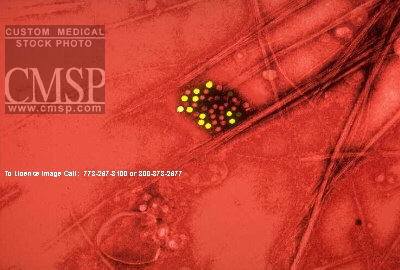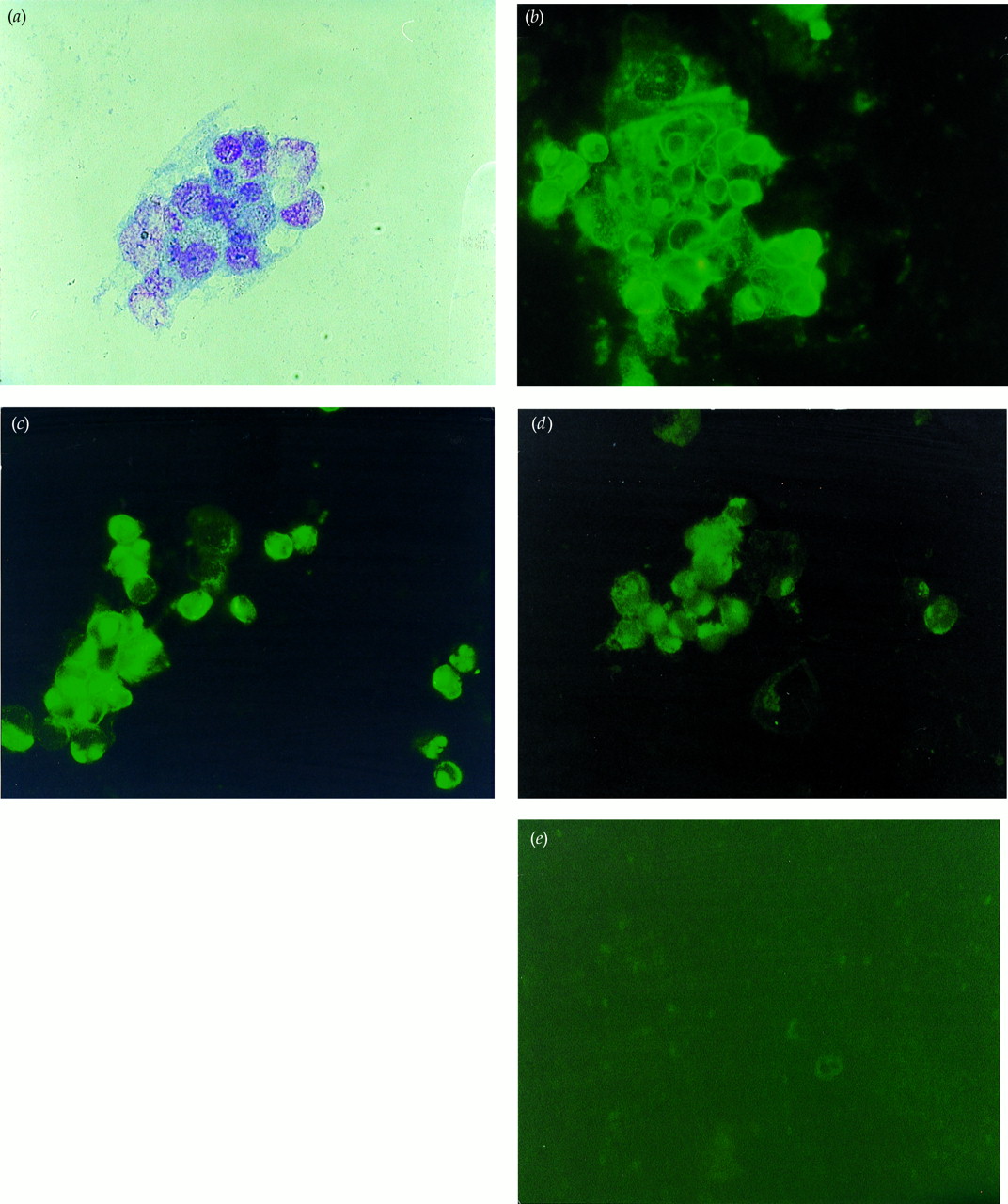
New Findings from 1999-2000

Colorized astrovirus from stool. 30-40NM X110,000 at 8X 10 B+W. Print here seen at 110,000X from a stool sample.
1
Application of electronmicroscopy, enzyme immunoassay, and RT-PCR to monitor an outbreak of astrovirus type 1 in a paediatric bone marrow transplant unit.
Cubitt WD et al. Journal of Medical Virology 1999; 57: 313-321.
Main finding:
A 1997 outbreak of astrovirus serotype 1occurred in a bone marrow transplantation pediatric unit where patients were treated for leukemias and inherited immune deficiency disorders. Monitoring the outbreak using electronmicroscopy (EM), enzyme immunoassay (EIA), and reverse transcription-polymerase chain reaction (RT-PCR) showed that many subclinical infections could only be detected through RT-PCR. Furthermore, RT-PCR demonstrated that several patients had been infected earlier and had shed virus longer than revealed by either EM or EIA.
What else was discovered in the study?
Thorough cleaning of the unit after the last case of gastroenteritis was associated with the ending of new cases of diarrhea in the unit. After the last case of symptomatic astrovirus infection, the ward was closed to new admissions. After this time, teaching sessions were given to the cleaning staff, guidelines for handwashing was emphasized, and the entire unit was cleaned with hot soapy water and alcohol wipes. A control infection team inspected the cleaned unit. The ward was reopened about a month later when screening of fecal samples from all 11 patients did not show any more cases of astrovirus infection.
The occurence of astrovirus infection in the hospital implicates that asymptomatic infection may be common or the virus may persist in the environment for a prolonged period of time. Perhaps hospital staff or visitors were transmitting the virus or the virus remained viable in the environment. RT-PCR testing revealed secondary astrovirus cases in cubicles that were previously used to treat patients who were copiously excreting the virus.
The authors of the study speculate that bedpan washing could generate infectious aerosols of astrovirus. Bedpan washes operate at 56 degree Celsius, and astroviruses are known to be resistant to degradation at this temperature.
If using EM or EIA to screen the presence of astrovirus in stool samples, fecal samples should be examined on several occasions even after a patient becomes asymptomatic and appears to have eliminated the virus for effective control of an outbreak. RT-PCR testing revealed that the concentration of shedded virus may drop below the level of detection of either EM or EIA on some occasions but then rise above the detection threshold at later occasions.
The use of oral hyperimmune gammaglobulin with a high concentration of astrovirus-specific IgG antibodies did not prevent viral replication. Though the administration of this gammaglobulin in patients aggregated viral particles into large immunecomplexes seen in fecal samples, it did not deter viral replication.
The relative importance of cell-mediated immune responses over humoral responses was implicated. In one patient, detection of T cells was followed by a decrease in the copious shedding of astrovirus that had previously been occuring for more than 2 months.
2
Processing and intracellular location of human astrovirusnon-structural proteins
Willcocks MM, Boxall AS, and Carter MJ. Journal of General Virology 1999; 80 (10): 2607-2611.
ORF 1b encodes RNA-dependent RNA polymerase while ORF 1a encodes a variety of proteins including a serine protease. A nuclear addressing signal was found to be present on the carboxyl half of the ORF 1a polyprotein in earlier studies. Though the presence of this signal may suggest that ORF 1a protein products are transported to the nucleus, it does not conclusively prove it, for nuclear addressing signals have been found to be present on proteins that remain outside of the nucleus.
ORF 1a and ORF 1b nonstructural protein products were expressed and specific antisera were raised them. The study revealed that ORF 1a protein products aggregate in the nucleus while those expressed from ORF 1b remain in the cytoplasm.
The transport of viral proteins to the cell nucleus may yet be another distinguishing feature of astrovirus, for nuclear involvement in non-enveloped RNA viruses is considered to be unusual.

Localization of astrovirus-specific proteins within infected cells revealed by immunofluorescence. Figures are labelled (a)-(e) from left to right. (a) Mock-infected CaCo-2 cells stained withGiemsa to reveal the nuclei. (e) Mock infected CaCo-2 cells. (b)-(d) Astrovirus-infected cells; (b) Anti-astrovirus structural protein antiserum. (c, e) Anti-ORF 1a nuclear addressing region antiserum. (d) Anti-ORF 1b antiserum.
3
Human astrovirus-associated gastroenteritis in children under 2 years of age followed prospectively during a rotavirus vaccine trial
Pang W-L and Vesikari T. Acta Paediatr 1999; 88: 532-6.
Placebo and rhesus rotavirus tetravalent (RRV-TV) vaccine recipient children were followed from 2 months to 2 years of age in order to determine the clinical significance of astrovirus-related gastroenteritis in young Finnish children. RT-PCR was used to test stool specimens for astrovirus, and positive results were confirmed by Southern hybridization using probes for astrovirus serotypes 1 and 2.
Findings:
4
Molecular epidemiology of childhood astrovirus infection in child care centers
Mitchell DK et al.The Journal of Infectious Diseases 1999; 180: 514-7.
RT-PCR and sequence analysis was used to determine the astrovirus antigenic types found in outbreaks and sporadic cases of diarrhea among children in child care centers.
Findings:
5
Astrovirus enteritis in a chronic lymphocytic leukemia patient treated with fludarabine monophoshpate
Coppo P et al. Ann Hematol 2000; 79: 43-45.
Severe astrovirus gastroenteritis was reported in a patient with chronic lymphocytic leukemia undergoing fludarabine monophospate treatment (FAMP, an immunosuppressive drug.) EIA and EM were used to detect the virus in stool specimens. The authors suggest that astrovirus could be a common cause of gastroenteritis observed in patients with hematologic malignancies and who are immunocompromised due to drugs such as FAMP.
6
Detection of astrovirus gastroenteritis in children
McIver CJ et al. Journal of Virological Methods 2000; 84: 99-105.
A year-long survey of enteric pathogens was conducted in children in both outpatient and hospital settings in Australia.
7
Genetic variation in the capsid region of human astrovirus serotype 4 isolated in Japan
Hachiya M et al. 43(11): 1067-1070.
The complete capsid regions of astrovirus serotype 4 from Japan were sequenced using RT-PCR and compared to other serotypes. The hypervariable region on the C terminus of the capsid region is known to be an immunoreactive epitope exposed on the virion surface.
Serotype 4 isolates were subdivided into two new subgroups based on the hypervariable region of the C terminus of the capsid region.
The homologies between the two subgroups (85%) were greater than those among different serotypes (less than 50%), but inters-subgroup homologies were lower than intra-subgroup homologies (more than 93%).
Though there were no observed differences in clinical symptoms between the two subgroups, the genotypic differences between the groups were speculated by the authors to possibly affect antigenicity and epidemiology.
8
Prevalence of antibodies to astrovirus types 1 and 3 in children and adolescents in Norfolk, Virginia
Mitchell DK et al. Infectious Disease Journal 1999; 18: 249-54.
The observed decrease in seroprevalence to human astrovirus serotypes 1 and 3 from an age younger than 3 months to 6-11 months is consistent with the loss of antibodies acquired from the mother that occurs with increasing age during infancy.The peak seroprevalence rates for children aged 6-9 years indicates frequent exposure to astrovirus and other enteric viruses during infancy and early childhood.
9
Epidemiology of astrovirus infection in young children hospitalized with acute gastroenteritis in Melbourne, Australia, over a period of four consecutive years, 1995 to 1998
Mustafa H, Palombo EA, and Bishop RF. J Clin Microbiol 2000;38(3): 1058-1062.
The incidence of acute astrovirus-related gastroenteritis was determined in hospitalized children younger than 5 years of age, using northern hybridization and RT-PCR Astrovirus was detected in 40 out of 449 stool specimens.
The incidences of astrovirus each year:
In 1995 and 1997, the incidences of astrovirus infection was greater than gastroenteritis due to individual bacterial pathogens, and they were greater than or equal to the incidences of adenovirus infection. Genetic analysis of the ORF 2 sequence showed variation from year to year, but this variation did not result in significant amino acid substitutions.
10
Absence of human astrovirus RNA in sewage and environmental samples
Eggleston SI, Caul EO, Vipond IB, and Darville JM. J Appl Microbiol 1999; 86(4): 709-14.
During the summer of 1996, samples of sewage, seawater, river water, and silt were collected from sewage works from coastal areas at and near Weston-super-Mare, England. These samples were tested for astrovirus using RT-PCR, and astroviral RNA was not detected in any of the samples. This result suggests that contamination of astrovirus in this environment is not a problem during the summer.